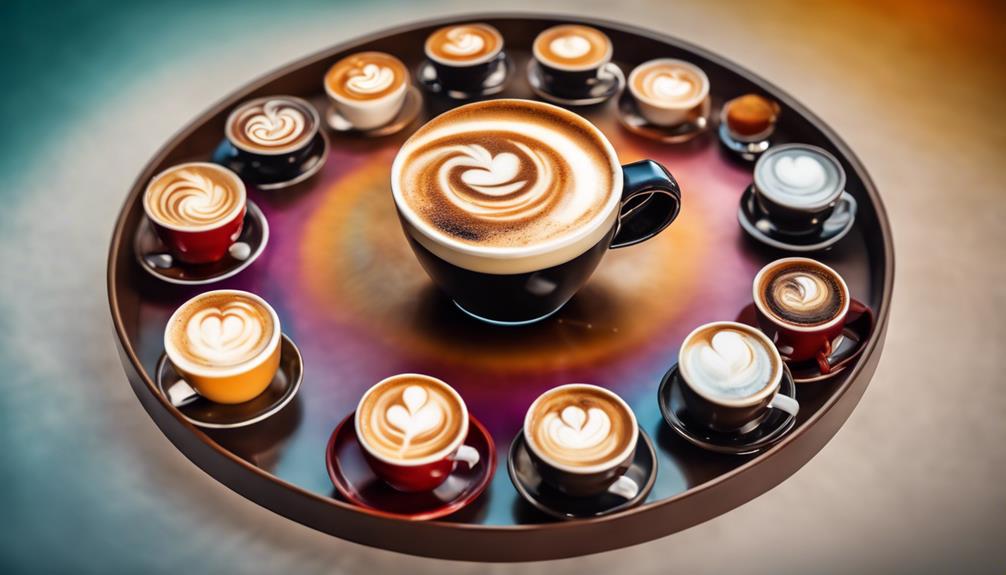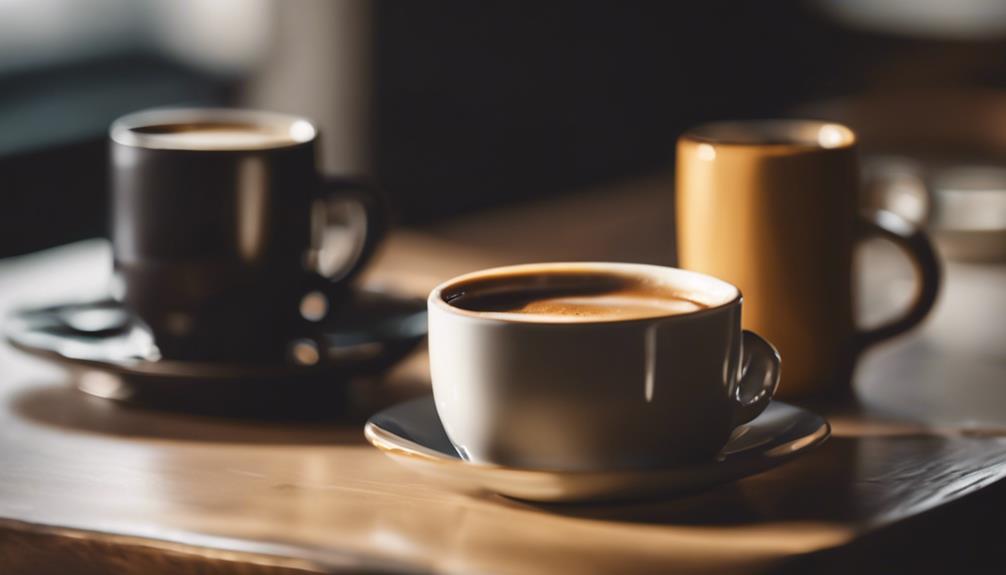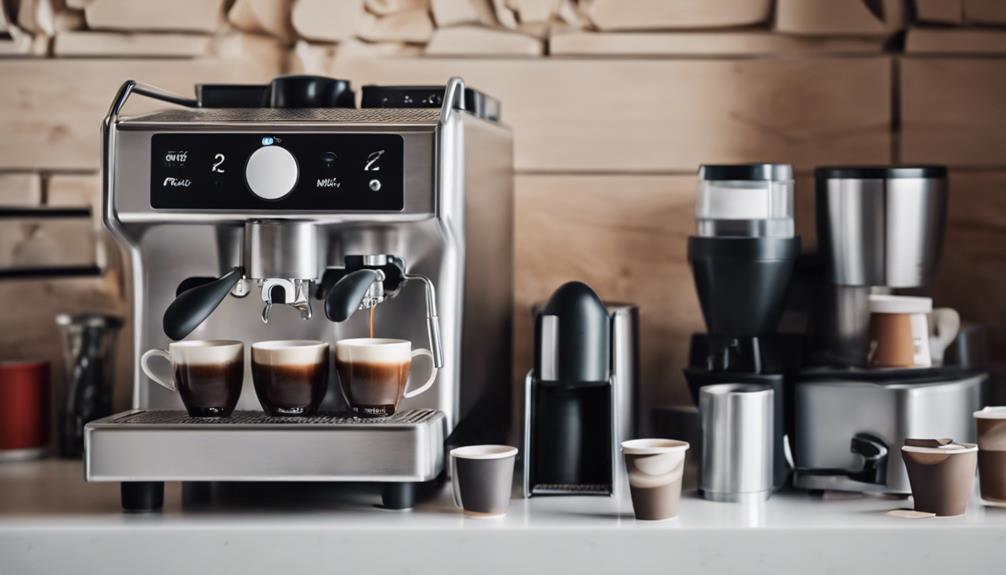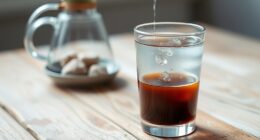You are just one sip away from discovering the perfect espresso drink! From Americano to Mocha, each drink has its own unique characteristics, and it all starts with the ideal coffee-to-water ratio of 1:2. Balancing brewing temperature, extraction time, and grind size is key to achieving that perfect shot. Next, combine it with steamed milk and flavorings to craft your favorite drink. Whether you prefer lattes or cappuccinos, mastering the basics will enhance your coffee experience. So, get ready to dive into the world of espresso and find the perfect blend that fits your taste!
Key Takeaways
- An Americano is a double shot of espresso diluted with hot water, offering a smooth flavor.
- A Latte combines espresso and steamed milk in a 1:3 ratio, creating a creamy texture.
- A Cappuccino balances equal parts espresso, steamed milk, and milk foam for a harmonious taste and texture.
- A Macchiato features a shot of espresso "stained" with a small amount of steamed milk or foam, preserving a strong flavor.
Understanding Espresso Fundamentals
When you brew espresso, you're working with a precise science that requires a deep understanding of the fundamental factors that impact the final product. To get it right, you'll need to balance the ratio of coffee to water, the brewing temperature, and the extraction time. Typically, you'll need 7-9 grams of coffee for a single shot and 14-18 grams for a double shot.
The ideal brewing temperature ranges from 190°F to 205°F, with an extraction time of 20-30 seconds to produce 1-2 ounces of espresso.
A well-pulled espresso shot is a masterclass in balance, featuring a rich flavor profile with acidity, sweetness, and bitterness in harmony. It's topped with a glossy layer of crema, which is a hallmark of expertly brewed espresso.
The espresso-to-water ratio is considerably stronger than regular filter coffee, typically 1:2 compared to 1:15. This concentrated coffee serves as the foundation for a variety of espresso drinks, from Americano to mocha.
Exploring Popular Espresso Drinks
You're now ready to venture into the world of espresso drinks, where a shot of concentrated coffee serves as the base for a diverse range of creations. As you explore this vibrant coffee culture, you'll discover a variety of espresso drinks that cater to different tastes and preferences.
Let's start with the Americano, a smooth and rich drink made by diluting a double shot of espresso with hot water.
If you prefer a creamier drink, you might enjoy a Latte, which combines espresso and steamed milk in a 1:3 ratio. The Cappuccino is another popular option, featuring equal parts espresso, steamed milk, and milk foam.
For a stronger espresso flavor, try a Macchiato, where a shot of espresso is 'stained' with a small amount of steamed milk or foam.
Finally, indulge in a Mocha, a delightful combination of espresso, steamed milk, and chocolate syrup, often topped with whipped cream.
With these popular espresso drinks, you're sure to find the perfect cup that suits your taste buds.
The Art of Milk Steaming Techniques
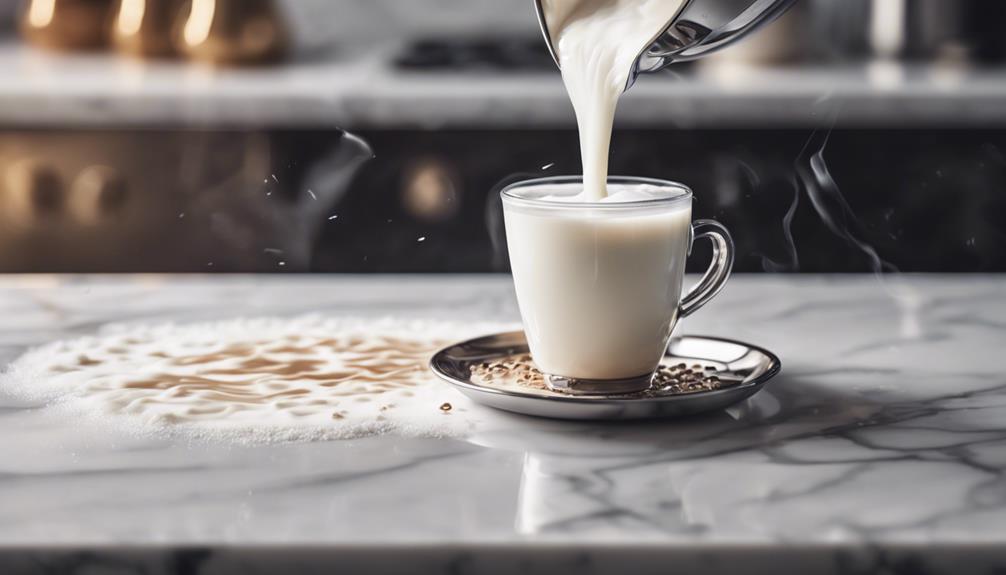
As you immerse yourself in the world of espresso, mastering the art of milk steaming techniques becomes essential to crafting velvety-smooth drinks that delight the senses.
Steaming milk is a vital step in creating a creamy texture in drinks like lattes and cappuccinos, enhancing their mouthfeel and flavor profile. To get it right, you'll want to aim for an ideal temperature of 130°F to 150°F (54°C to 65°C), as overheating can alter the milk's sweetness and texture.
When steaming milk, you'll need to control the aeration levels to achieve the perfect foam on top. Minimal aeration is ideal for drinks like cortados, while increased aeration produces the stiffer foam needed for cappuccinos.
Proper positioning of the steam wand in the milk pitcher is also vital, as angling it allows for better incorporation of air, leading to a velvety microfoam.
With practice, you'll be able to achieve a smooth, glossy surface without large bubbles, giving your espresso drinks a professional finish. By mastering these milk steaming techniques, you'll be well on your way to crafting delicious, velvety-smooth drinks that will impress even the most discerning coffee connoisseurs.
Espresso Drink Variations Explained
Mastering milk steaming techniques is just the beginning; now it's time to explore the diverse world of espresso drinks, each with its unique flavor profile and texture. You've got the foundation right – a perfectly pulled shot from your espresso machine, using high-quality coffee beans.
Now, it's time to experiment with different ratios of espresso to milk and flavorings to create a variety of drinks. You can opt for a traditional macchiato, with a shot of espresso 'stained' with a small amount of frothed milk, or modernize it with more steamed milk.
Go for a cappuccino, following the 1:1:1 ratio of espresso, steamed milk, and milk foam for a balanced flavor and texture. If you prefer a stronger coffee flavor, lattes are the way to go, with a double shot of espresso combined with steamed milk in a high milk-to-espresso ratio.
And for those with a sweet tooth, the mocha is a decadent treat, combining espresso with chocolate syrup and steamed milk. The possibilities are endless, and it's up to you to experiment and find your perfect cup!
Brewing Espresso to Perfection
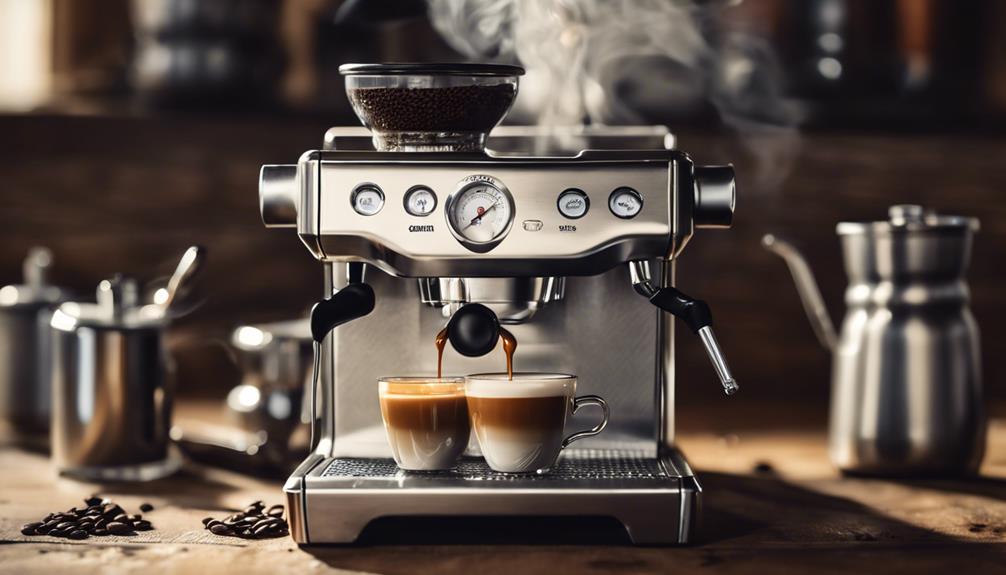
When brewing espresso to perfection, you'll need to get the basics right.
You're about to learn the essential factors that make all the difference, from the perfect grind size to the ideal water temperature.
Espresso Brewing Essentials
You force hot water through finely-ground coffee under intense pressure to brew espresso to perfection. Specifically, you're pushing water at around 200°F through the grounds at 9 bars of pressure for 20-30 seconds.
To get it just right, you need the ideal coffee-to-water ratio of 1:2. For a single shot, that means 7-9 grams of coffee, and for a double shot, it's 14-18 grams.
When you get the ratio and brewing time spot on, you'll be rewarded with espresso that's rich in flavor, thick in consistency, and topped with a creamy layer of crema.
But it's not just about the brewing process – regular maintenance of your espresso machine is essential too. Make sure to clean the portafilter and steam wand regularly to prevent buildup that can affect the flavor of your espresso.
Proper Grind Size Matters
By nailing the perfect grind size, you'll reveal the full flavor potential of your espresso beans and set yourself up for a beautifully balanced shot. Getting it right is essential, as the grind size directly affects the flavor and quality of your espresso.
Here's what you need to know:
- Aim for a grind size that resembles table salt – fine, but not too fine.
- A proper grind size increases the surface area of coffee, allowing for ideal contact with hot water during brewing.
- If you get it wrong, you'll end up with a shot that's either too weak or too bitter.
Optimal Water Temperature
To brew espresso to perfection, the water temperature must be precisely controlled, falling between 190°F and 205°F (88°C to 96°C), to guarantee the ideal extraction of flavors.
If you're brewing at temperatures lower than 190°F, you risk under-extraction, leading to a sour taste. On the other hand, temperatures above 205°F may cause over-extraction, resulting in bitterness. Consistency is key, as even slight variations can greatly impact the quality of your espresso shot.
Fortunately, espresso machines are designed to heat water to these precise temperatures, ensuring that the brewing process produces a rich and flavorful shot.
To achieve the best results, it's crucial to regularly maintain and calibrate your espresso machine. This will help you sustain the perfect brewing temperature, shot after shot.
The Importance of Coffee-to-Water Ratio
Getting the coffee-to-water ratio right is essential, as it directly impacts the flavor and strength of your espresso. Even slight variations can make a significant difference in the final product.
As you experiment with different ratios, keep in mind that the typical ratio for espresso is 1:2, which yields a stronger brew compared to filter coffee.
Here are some key points to take into account when adjusting the coffee-to-water ratio:
- A higher coffee ratio yields a more concentrated and intense taste, while a lower ratio produces a milder beverage.
- Precision in measuring the coffee-to-water ratio is essential for consistency, as even slight variations can alter the strength and taste of the espresso.
- The ideal brewing time for espresso, which affects extraction, generally ranges from 20 to 30 seconds.
Espresso Culture and Trends Today
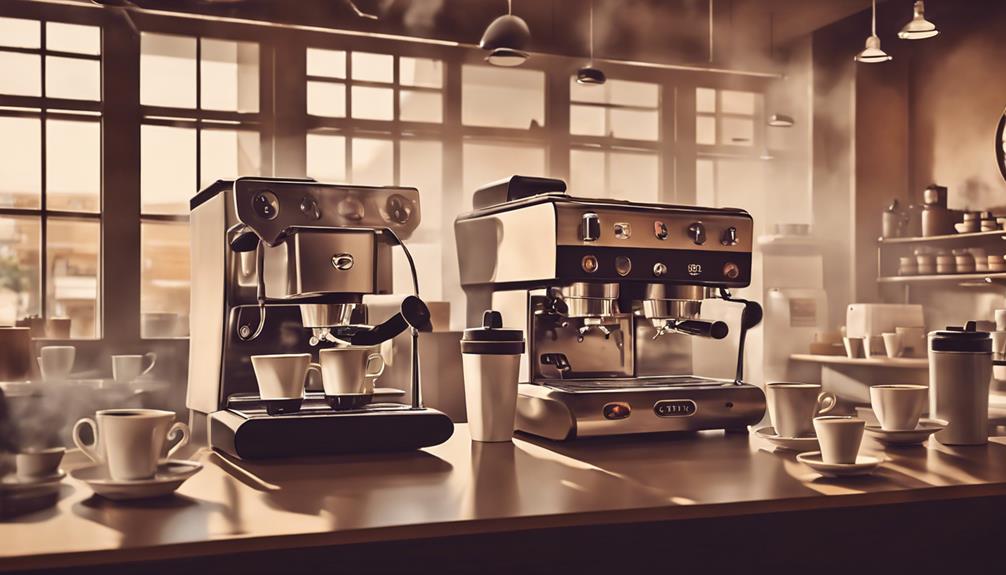
As you explore the world of espresso, you're likely noticing some exciting trends and shifts in coffee culture. One trend that is gaining popularity is the emphasis on sustainable and ethically sourced coffee beans, with many consumers seeking out Fair Trade and organic options. Another shift in coffee culture is the rise of home espresso enthusiasts, who are investing in high-quality espresso machines and honing their barista skills. For those looking to maintain their espresso machines, it’s important to follow proper espresso machine maintenance tips to ensure the longevity and optimal performance of the equipment. Regular cleaning, descaling, and checking for any worn or damaged parts are essential for keeping your espresso machine in top shape.
From unique brewing methods to innovative flavor combinations, the way we experience espresso is changing rapidly.
You're about to discover the latest developments driving this evolution, from emerging trends to the ways coffee shops are adapting to meet consumer demands.
Espresso Trends Today
You're likely noticing a shift in the way your favorite coffee shops operate, with a renewed focus on artisanal espresso preparation that showcases unique brewing techniques and premium bean quality. This shift is driven by the rise of specialty coffee shops, which prioritize quality and craftsmanship over mass production. As a result, you're seeing more innovative espresso drinks and brewing methods that cater to your refined taste.
Some notable trends in the espresso world include:
- Visually stunning coffee drinks taking over social media, with Instagram-worthy designs and flavors.
- The emergence of cold brew and nitro coffee as competitors to traditional espresso, leading to exciting hybrid drinks.
- A growing emphasis on sustainability, with consumers seeking ethically sourced coffee and eco-friendly practices from their favorite coffee shops.
Coffee Culture Evolution
The espresso culture evolution has transformed the way enthusiasts experience coffee, with social media platforms fueling the desire for unique, high-quality espresso drinks and sustainable practices. As you investigate the world of espresso, you'll notice a shift towards artisanal and specialty coffee. Coffee tourism has become a thing, with enthusiasts traveling to experience authentic espresso tasting sessions in various countries.
| Trend | Description |
|---|---|
| Specialty Coffee | High-quality, unique espresso drinks |
| Coffee Tourism | Traveling to experience authentic espresso |
| Sustainable Sourcing | Focus on ethical and environmentally-friendly practices |
| Cold Brew & Nitro | New competition for traditional espresso drinks |
| Hybrid Beverages | Innovative adaptations in coffee menus |
You're part of a growing community that values quality, sustainability, and creativity in their coffee. The global espresso market is projected to grow considerably, driven by your demand for specialty coffee and artisanal espresso drinks. As you explore the world of espresso, remember that you're contributing to a culture that's constantly evolving and innovating.
Frequently Asked Questions
What Coffees Should a Barista Know?
You should know the classics: Americano, Latte, Cappuccino, Macchiato, and Mocha, each with unique ratios and ingredients. Mastering these will help you navigate variations and customizations that cater to local coffee cultures and preferences.
What Drink Has 3 Shots of Espresso?
You're wondering what drink packs a punch with three shots of espresso? Well, it's a triple shot or triple espresso, providing a robust caffeine boost and rich flavor in a small cup or as a base for larger drinks.
What Is a 1 to 1 Espresso Drink?
You're wondering what a 1 to 1 espresso drink is? It's a beverage that combines equal parts espresso and steamed milk, creating a balanced flavor profile that's strong yet smooth, with the milk enhancing the espresso's rich taste.
How Do You Compare Coffee and Espresso?
Think of coffee and espresso like a marathon and a sprint – they're both coffee, but one's a slow, steady pace, while the other's a concentrated burst of energy and flavor.
Conclusion
Savoring the sweet spot of espresso expertise, you've now mastered the majestic menus of mouthwatering mochas, luscious lattes, and bold brews.
From fundamentals to fancy foam, you've frolicked in the fascinating world of coffee culture.
With this extensive crash course, you're perfectly poised to pour, pull, and precision-brew your way to a profound passion for the perfect cup.
Cheers to your caffeinated conquest!
